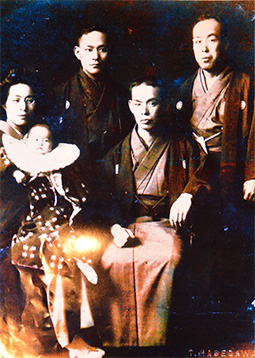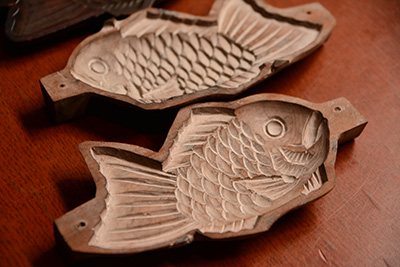May 2023
- English
- 日本語
Taiyaki—Fish-Shaped Sweets Baked by a Venerable Old Shop
-

-

A smiling Kanbe Masamori, owner of Naniwaya Sohonten, in front of his shop
-

The batter for the crust is quickly poured into a special baking tool (metal mold). (Each taiyaki is made one by one in this baking tool.) -

Kanbe Masamori's grandfather, Genjiro Kanbe (back row, left), who founded the current Naniwaya Sohonten about 110 years ago (photo courtesy of Kanbe Masamori) -

Naniwaya Sohonten's sister shop opened about 100 years ago. At that time, the price of a single taiyaki was 1 sen. (Photo courtesy of Kanbe Masamori)

Taiyaki is a traditional Japanese sweets baked in the shape of a sea bream (tai). We talked about taiyaki with Kanbe Masamori, owner of an old taiyaki shop in Tokyo that attracts many customers from outside Japan.
"Taiyaki is made by pouring a batter made from flour dissolved in ice water into a special mold and baking it with a filling of sweetened red bean paste. The crust is crispy, with a texture that may be familiar to those from countries where crispy crepes are served."
So says Kanbe Masamori, owner of Naniwaya Sohonten, a shop that has been in the Azabu Juban district of Tokyo for many years. Kanbe tells us that this traditional delight has been around for more than 110 years. On a busy day, he sells 2,000 of them.

According to Kanbe, the fourth-generation owner of the shop, taiyaki was invented by the first-generation owners in the early 20th century.
The first-generation owners were brothers from Kobe, Hyogo Prefecture. They started a business, and that became the foundation for the taiyaki shop. In 1909, each brother opened a shop in Tokyo, and Naniwaya's taiyaki became a big hit. At one time, they had as many as 150 franchise locations all over Tokyo.

"In those days, during the Meiji Era (1868-1912), wedding gifts included grilled sea bream, as well as sugared confections in the motif of sea bream, which was a luxury fish that people could rarely eat. I believe that Japanese people in olden times had more of a yearning for sea bream than they do today. I think the first-generation owners, who had business smarts, invented these sweets in the shape of a sea bream based on the idea of offering sea bream that could be easily bought for 1 sen per piece. 1 sen from back then would feel like about 200 yen nowadays."

These popular baked sweets with a sea bream shaped crust filled with anko (sweetened red bean paste) have been passed down for more than 110 years as a traditional sweets.

"At Naniwaya, we are particular about the red bean paste used to fill the crust. Since we care about the aroma, texture, and flavor unique to beans, we use our own homemade bean paste, which we cook in the shop every day," Kanbe explains.
Another feature of Naniwaya's taiyaki is the crust, which is thinner and crispier than those of other shops.
"We use a thin crust to let you enjoy that bean paste flavor to the fullest." When you visit Japan, we'd love to have you enjoy the taste of our special sweets."


